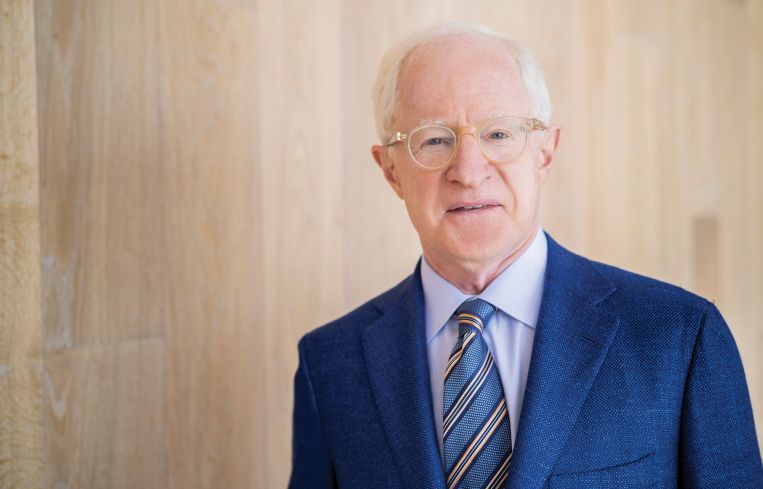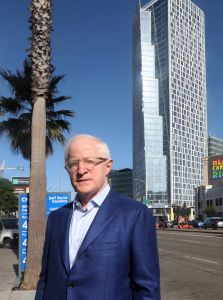Related California Founder William Witte On What’s Next
Witte has been a force for decades in affordable and market-rate housing development — and now might be his toughest stretch yet
By Greg Cornfield September 22, 2025 2:05 pm
reprints
William Witte has spent decades shaping the built environment of California, from high-rise towers in Downtown L.A. to subsidized housing complexes.
As chairman and CEO of Related California — one of the biggest developers in the state — Witte oversees the firm’s market-rate and affordable housing arms. He recently spoke with Commercial Observer about affordability issues for renters, cost issues for developers, what the recent reform of California’s environmental review law has meant, and more.
This conversation has been edited for length and clarity.
Commercial Observer: How has Related California’s been doing over the past 12 to 18 months in Southern California?

William Witte: We’re a little unique because we have two divisions. One does only affordable housing, and the other does market-rate, mixed-income and mixed-use projects, and I oversee both.
On the market-rate side, a trend over the last three to five years is market-rate development traditionally has been urban — downtown, often high-rise. And, while we’re still in that world, we’ve begun taking on what I would call urban projects in suburban locations.
In Southern California, the most notable is the Related Bristol project, which is a fully entitled 42-acre, sort of old-school, single-story shopping center in Santa Ana, right next to South Coast Plaza. That is approved for up to a little over 3,000 multifamily apartment units, 350,000 feet of retail, a hotel and a senior living building.
We hope to get financing in place and start construction sometime in 2026.
Another Orange County project is a two-tower, 140-unit condominium project in Fashion Island in Newport Beach, which is on the site of the old Regal Cinema.
We’re also, in a month, opening an eight-story, 275-unit mixed-income apartment project at 700 Broadway in Santa Monica atop the new 50,000-square-foot Vons supermarket. Vons had been on the site for years, sold it to us because they wanted to build a bigger store. So we paid them for the site, and took a good bit of those funds to build the new store along with the apartments — and that should open within a month.
What drove the move to urban projects in suburban locations?
COVID really hurt urban downtowns. And Downtown L.A., where we had been active, really has gotten hurt post-COVID — commercial, residential, everything.
Return-to-work, more homeless — it’s been a challenge. I think it’s bottomed out, but it’s been a challenge.
A lot of people have talked about the California “exodus” — major employers and big businesses leaving. Does that have a big part to do with this as well?
I actually don’t think that’s it, despite all the publicity. I think the bigger problem for California is working- and middle-class people leaving for affordability.
Yes, there’s some high-profile move-outs of major companies, although they often leave behind many of the employees and workers who don’t move with the corporate headquarters. It’s not that none have moved out, but you see the Bay Area with AI and some other things. There’s things opening up and moving in too. So I think that’s a little more complicated.
But I think the big problem — everywhere in California — is affordability. The home ownership rate nationally and certainly in California is dropping.
But the return-to-work part, especially in the downtown areas, where there were more issues like homelessness, is definitely a problem
When you see the reform to the California Environmental Quality Act, or CEQA,, does that make significant headway toward providing more market-rate affordability for the middle class?
I wouldn’t even just say for the middle class. I’d say for any housing that meets those tests. And I think the CEQA reform is huge.
A lot of cities, including in L.A., have moved to expedite permit processing. That helps. But it doesn’t move the needle on feasibility.
Whereas the CEQA reform — it can take years off your approval process, during a time in which costs can go up — which, of course, has recently happened. So that’s hugely, hugely significant.
I will say — not just for L.A. or Southern California — the bigger feasibility problem has been the increase in both operating costs, especially insurance and construction costs. And they may have leveled off, but since COVID, construction costs have gone up 30 percent to 40 percent at least, and then interest rates went up.
So, if you’re in the market-rate world and you’re trying to convince an investor of a certain return, it’s much harder to achieve. So, rents will have to keep going up.
I know that seems anti-affordability, but it’s just the market, to enable projects to pencil, given the increase in both operating expenses and construction costs.
Are there any tools or incentives from the state or counties that could help bridge the gap?
Well, I think the challenge — especially at the state level — is they are proposing a lot of housing legislation. But, with the exception of at least part of the recent CEQA reform, any state incentive is going to have high labor standards. I’m not saying that’s a bad thing, but most of the market-rate development world does not pay prevailing wages, particularly for wood-frame construction. So the incentives don’t get utilized as broadly as one might hope. And people know that. But that’s just a political fact of life.
Instead of just incentives, do no harm. San Francisco, for example, has moved down this road a little. Don’t add requirements. Don’t make it more expensive.
When it comes to local transfer taxes, this is an awkward issue for us because we’re on both sides of the ULA [Los Angeles’ surcharge on larger real estate trades]. Santa Monica and San Francisco already have transfer taxes.
On the market-rate side, to the investor community, it simply reduces the value of your project. Well, if you’re already struggling — even without a transfer tax — for economic feasibility, that hurts.
On the affordable side — I have to admit — we just started construction on a 105-unit affordable project on a surplus state site on Washington Street, south of South Park. It has ULA funding from the city. The funding on the affordable side is all about subsidies and money.
Sure, it helps. However, the city has not gotten as much as it thought that it might.
Without jumping into the fray, because it’s being litigated now, but it’s kind of passing the affordability buck from the public sector to the private sector. But, on the other hand, L.A. passed Measure A [a countywide half-cent sales tax to help address homelessness through supportive housing development, and to make housing more affordable in L.A. It was approved by voters last year and went into effect on April 1]. So it’s a mixed bag.
The cities are trying, mostly, to help. But what can cities really do? They can affect land-use regulations. Some have been more aggressive than others. And the state pressure on cities to develop housing — or zone for housing — has helped a lot.
We’re doing an affordable project in Downtown Laguna Beach two blocks from the ocean. I’m not sure that would ever have gone forward without state pressure. It’s not approved yet, but it’s under legislation that will essentially guarantee approval.
To some degree, cities can help financially. They can make permit processing more efficient. But they don’t affect macro issues like interest rates and construction costs — unless they add requirements.
Cities alone can’t do it. And the state could make some difference, as it has done with housing, with the investor community. The investor community, I don’t want to say has red-lined California, but there is a deep suspicion in the investor community about over-regulation. And even if a regulation isn’t in place today, it might be tomorrow. And how do you say that when you have a lot of constituencies on the labor and other sides pushing for requirements and regulation?
It is a challenge right now accessing capital for major projects, mostly because of cost and interest rate uncertainty, but also because there is a perception, almost more than there needs to be, that this climate is over-regulated and will continue to be.
With that said, and with the financial hurdles that everyone has to deal with, how do you see the next 12 to 18 months unfolding?
I think the biggest question in the next 12 to 18 months is uncertainty.
If you’re an investor — or, for that matter, a developer — and you’re trying to underwrite a deal: What interest rate do you assume? What cap rate do you assume? Which is a function of interest rates, too.
We have it on the construction side. Yes, we proceed, and we assume some impact of tariffs — it’s not huge, but there remains some question there.
So the big question is uncertainty. At a micro real estate level, a number of these markets are strong. There is demand and a lack of supply.
This is what happens: Things don’t get built for a while. Rents come up. And then there’s a mini boom cycle. And I think that’s probably going to happen. Exactly when that happens is hard to tell. I don’t think I’m saying anything radical by saying, “There is uncertainty coming out of the federal level.” That’s being kind.
Will homebuilding take off again and take some of the pressure off the affordability market and for-sale housing? We don’t really know.
California in general, and many cities, have moved to be more aggressive in zoning for housing, as they’re essentially required to do by the state, with a few exceptions. So that’s a good thing. So there’s a lot teed up, or could be teed up if some of these macro factors become less inhibiting.
What does the pipeline look like on the affordable side?
In California and Oregon, we have a pipeline of 47 projects. Now, they don’t all happen in a timely manner. They’re all dependent on city, county or state subsidies.
We just broke ground on two or three projects in L.A. We’re doing our second homeless tower with the nonprofit Weingart Center in Skid Row. We just completed one. We’re just a fee developer — not a long-term owner.
We just broke ground on that 105-unit surplus site on Washington Avenue. And then we have a series of projects in Orange County, San Bernardino County, throughout the Bay Area. In L.A. County, we just opened a project in Alhambra.
But there’s a lot of uncertainty in the affordable world, too, because the state is running out of money that had been approved from prior bond measures to support affordable housing. There is a movement to put a $10 billion affordable housing bond on the ballot for November 2026. But, assuming it does go on the ballot, will it pass? We don’t know.
If it doesn’t, I think there will be a retrenchment on the affordable side, at least for new construction — because there won’t be enough subsidies to support all of these proposals.
Gregory Cornfield can be reached at gcornfield@commercialobserver.com.



